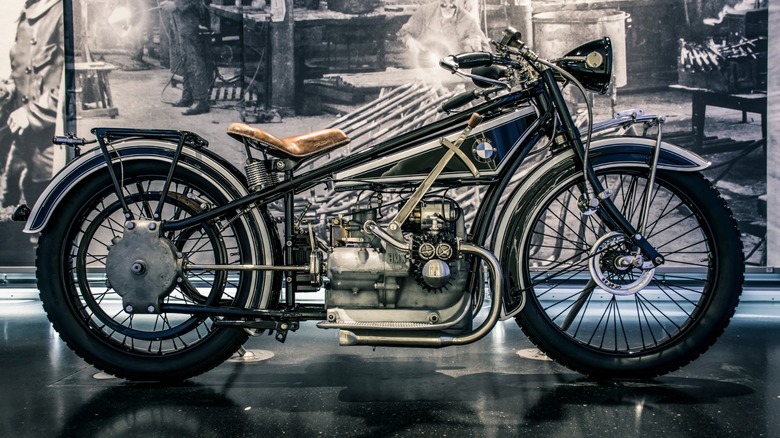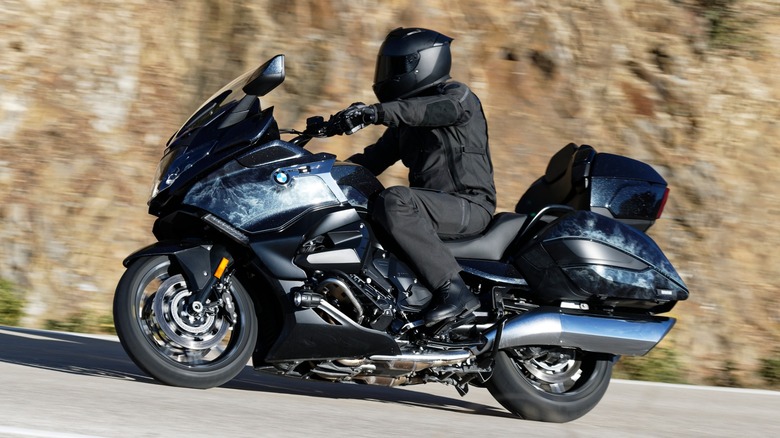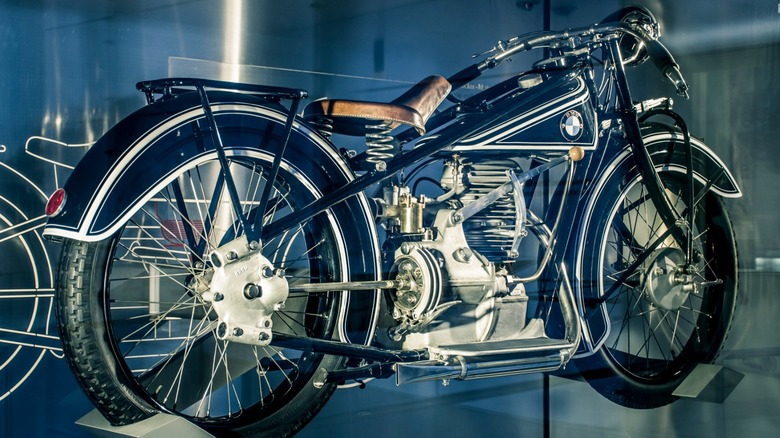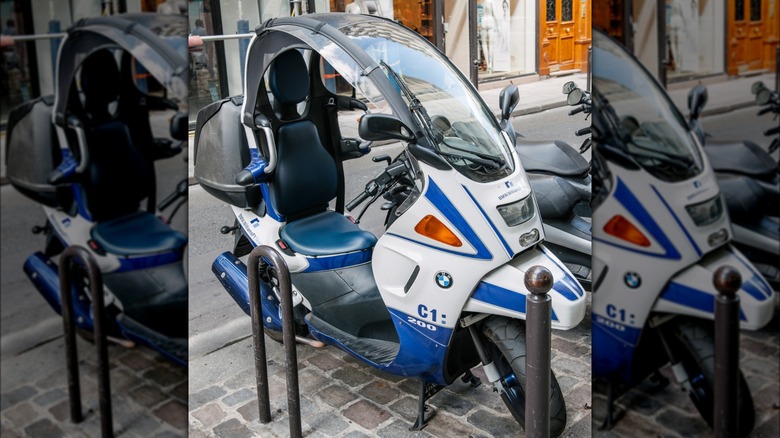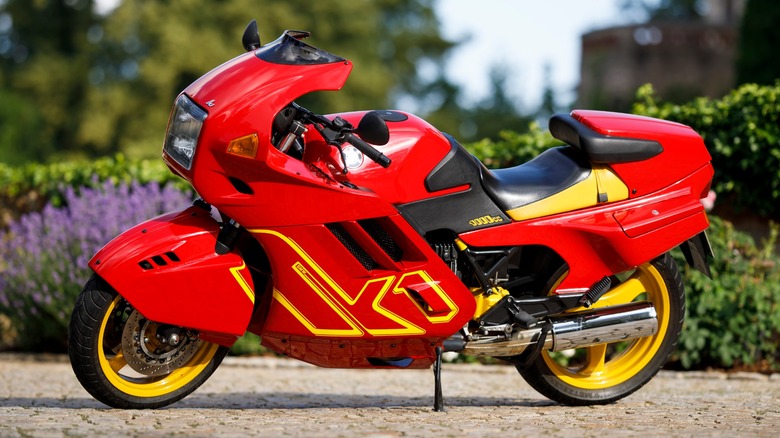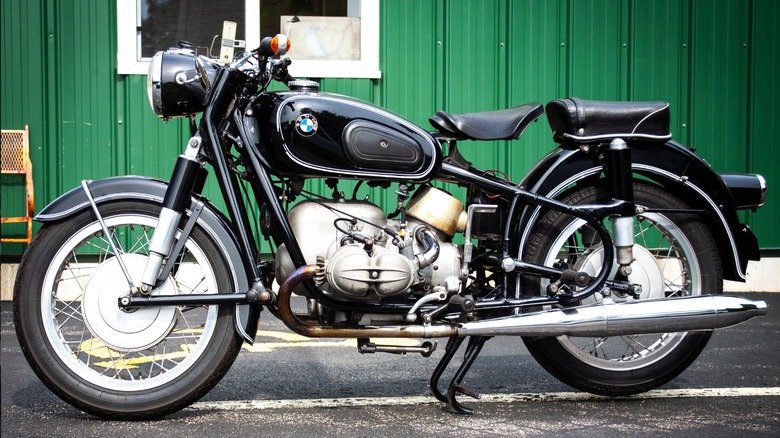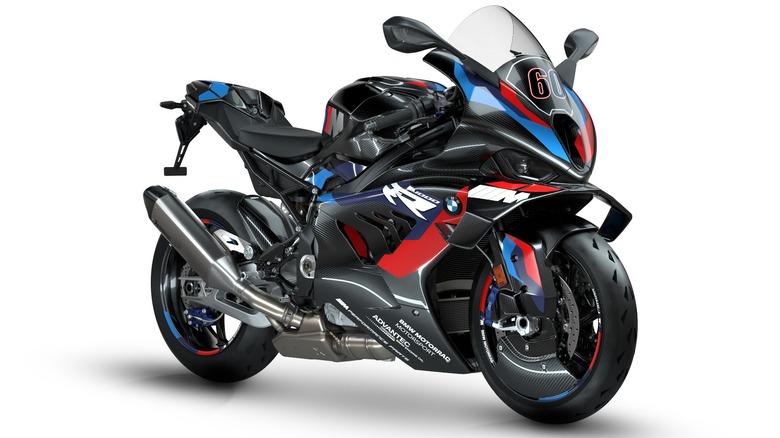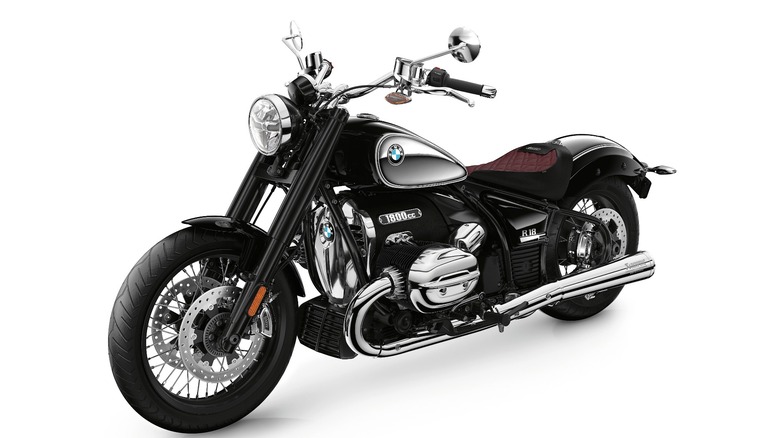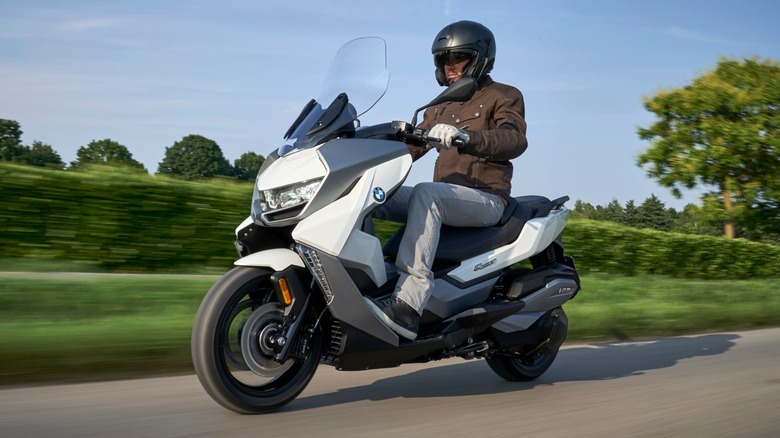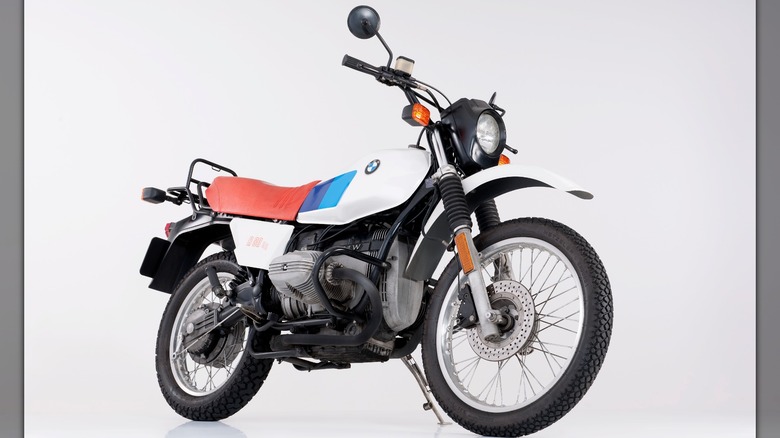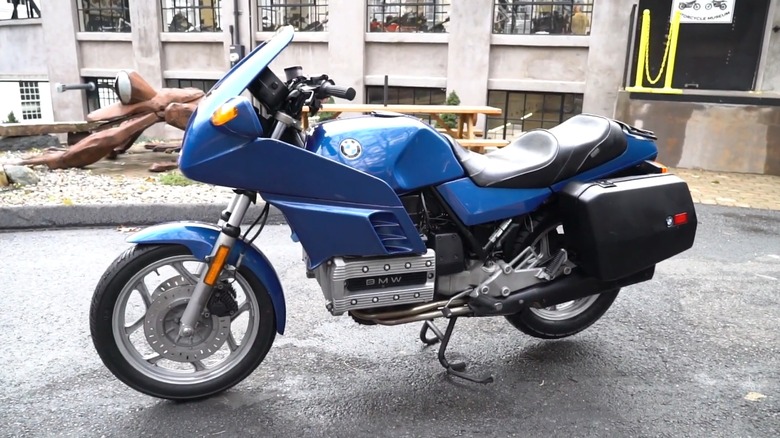10 Of The Coolest BMW Motorcycles Ever Made
Originally established as a manufacturer of aircraft engines, Bayerische Motoren Werke, commonly referred to as BMW and founded in Bavaria, was forced to retire its wings at the close of World War I. It then jumped into motorcycle manufacturing in 1923 as BMW Motorrad –- that's German for motorcycle -– and became known for developing breakthrough technology. In fact, the company introduced many motorcycle firsts such as ABS braking, digital engine electronics, and adaptive headlights.
As an avid rider of motorcycles since the age of 13, I appreciate the no-nonsense design of a BMW and the way they are built with more concern for how they ride over how they look. BMWs do not need tacky and flashy chrome to show off –- they are a true rider's bike. I have ridden most sizes and classes of motorcycle from 50cc mopeds to V-twin cruisers, so I genuinely appreciate a bike made with the rider's experience at the forefront. Nonetheless, BMW still manages to build attractive bikes with a distinct European flair.
Looking through more than a century of BMW motorcycles, you can find scores of cool models. Regardless, a few stand out. Considering bikes with particularly deft styling and a combination of clever features that elevate them above other contemporary machines, I have chosen 10 of the coolest bikes from BMW past and present with qualities such that any rider should be able to find something to like.
K 1600 Grand America Option 719 Midnight
BMW Motorrad is a German company that produces products that will sell well across its home continent of Europe. It is also a savvy company meant to turn a profit no matter where it is or what its home is, so it also builds bikes catering to the American market. European roads often travel routes that can be thousands of years old and generally lacks the wide open stretches of road common in areas like the American West, which means that BMW doesn't always have a reason to build large highway bikes. However, for riders wanting to hit the open road in style, BMW introduced in 2016 the K 1600 B, a cruiser built in the bagger style.
The K 1600 Grand America Option 719 Midnight is a motorcycle built for riding down long highways. Its power comes from an inline 6-cylinder engine with the cylinders tilted forward to keep the center of gravity low. The features and accessories rival those of a BMW 3 Series and include a wide driver's screen with an integrated Bluetooth audio system, navigation, multiple driving modes, as well as electronic engine and suspension controls. This is a big bike with ample storage that offers a super comfortable ride.
While this bike obviously targets big cruiser buyers with its $30,000 price tag, it is unique. Furthermore, it is not likely to overtake Harley-Davidson in sales any time soon and realistically not ever. Regardless, for someone who likes the cruiser but wants to retain some individuality, the bike from Berlin is a cool choice that will likely attract plenty of attention anywhere it goes.
BMW R32
Taking things all the way back to the beginning is the BMW R32, the company's first production bike. Right out of the gate, BMW took the lead in building innovative machines. The R32, introduced in 1923, came with a twin boxer engine, which kept the center of gravity low and the protruding cylinders received ample air for cooling. Furthermore, its wet-sump engine lubrication was superior to the total-loss oiling system that was common at the time, and the shaft drive provided durable reliability. It was a well-built premium machine with solid credentials.
Aside from being a clever piece of engineering, the debut R32 motorcycle was and still is a beautiful machine. Many bikes of the '20s, in my opinion, are not the most attractive two-wheelers. In 1923, motorcycles were still only a few years removed from being literal bicycles with engines mounted to frames. Some people may like these classic machines, but I think they lack the flourishes and style later motorcycles received that makes them special and appealing.
The Max Friz design of the R32 broke the 1923 motorcycle mold. The way Friz incorporated the fuel tank and merged the sloping line of the frame with the tail end of the bike is elegant as well as practical. The low-slung cylinders hanging off the sides prevent the mechanicals from breaking up the lines, and the deep fenders complete the look. No matter what angle you approach this machine from, it just looks cool.
BMW C1
Despite producing motorcycles since 1923, BMW had not built a single scooter — a popular mode of transport in Europe — before 2000. However, BMW eventually sought to get into scooter production to target a wider demographic by appealing to some of its car buyers with a safety-minded scooter including protection from the elements.
The C1, which was built by Bertone in Italy and debuted in 2000, had a 125cc 4-stroke engine with an upper section including a windshield and roof that were both affixed to a roll cage. The roll cage was crash tested by BMW and provided surprisingly good protection, although everything below the knees remained extremely vulnerable. Some countries even gave C1 owners exemptions to helmet laws. Furthermore, it came with seat belts to keep the rider within the protected area during a crash.
This thing did not sell well and was pulled after just two years. Nonetheless, it was an interesting concept with a noble purpose. It is also cool in a unique and peculiar kind of nerdy cool as a clever design and a rolling conversation starter. I participated in a sizable scooter rally around 2005, and someone had brought his C1 which he had imported and federalized to adhere to vehicle import rules. Despite the presence of very nice vintage vespas and modified Hondas, this unique BMW received more attention than anything else.
BMW K1
BMW's bikes for many years offered excellent power and handling on top of a reputation for reliability. However, its boxer technology prevented it from releasing the kind of pavement screamers that speed addicts wanted throughout the '70s, so it came late to the superbike arena. Truthfully, BMW did not have a true superbike until the modern era, but the predecessor came in the form of a limited production model in 1988, the K1, of which 6,900 units were made until production ceased in 1993.
With a K100 as its base, the K1 stepped things up with a 16-valve cylinder head, the first ever ABS on a motorcycle, and wind-tunnel-tested fairing. It is bold but the styling is also a bit polarizing –- Cycle World in 1990 even said that it looked like "something John Deere engineers mocked up the night that someone dropped rhino tranquilizer in the water cooler." Sure, but they did not yet have the power of nostalgia to influence their opinion, as the K1 is one of the most '80s motorcycles to ever '80s.
While it is a bike with excellent performance and handling characteristics with a buttery-smooth drivetrain, none of that matters next to its audacious and unendingly cool styling.
BMW R69S
Classic motorcycles will always be appealing to some riders. For those enthusiasts, modern conveniences and the reliability of electronic engine controls are nowhere near as appealing as a machine with completely analog controls that require regular upkeep and adjustment, even if the overall return is less power and worse handling.
Some of these folks like nothing but American V-twins while others go for the more exotic, and few motorcycles get more exotic than a BMW from the '50s or '60s. While they are not extinct, you might ride for years without ever passing one on any city street or highway. However, should you come across someone on a BMW R69S — which was introduced in 1955 and produced until 1969 — it should become immediately clear why they are riding it.
The R69S features the classic BMW boxer, although with several improvements over previous models, and its frame extends in a loop to the rear, adding strength and rigidity, something appreciated by riders of its day. With 14 years of production, there are countless variations of this model, including many fitted with sidecars. Setups for racing, touring, and everything in-between can be found, but what links them all are a classic look more subdued than American bikes and far better reliability than its British counterparts. There's a reason values can climb to $50,000 today, but looking cool on one remains priceless.
BMW M 1000 RR
Classic motorcycles on a leisurely stroll are fun, but hopping on a bike that can outrun nearly anything else on the road is just plain cool. If you have $39,940 for a well-optioned example, you could be that cool on a bonkers BMW M 1000 RR, one of the fastest motorcycles built to date.
BMW released its first genuinely competitive superbike in 2010, as the 1988 K1 suffered from a self-imposed horsepower limit of 100, which was far less than its competitors. Since its debut, the 1,000cc Bavarian bruiser has been turning heads on the street and track, garnering acclaim including the effusive praise lavished on it by professional racers in a 2013 issue of Cycle World. Since then BMW has been busy making it better.
The 2021 BMW M 1000 RR was the first BMW motorcycle to wear the prestigious M Series badge, and the result is the kind of machine that dares you to ride. When you do, it won't stop until its 205 horsepower launches to speeds approaching 200 mph. The list of technological aids and impressive specifications is lengthy, and nothing was spared in developing what could be the ultimate superbike. Yes it is very expensive, but it would be hard to say this monster is anything but cool.
BMW R 18
Classic motorcycles are always popular among some portion of riders who appreciate the vintage style that makes them so endearing. However, riding a vintage machine brings several issues with it that not everyone is ready to tackle. Among the pitfalls of a classic bike are low power and poor efficiency, and maintenance can be intensive while reliability can be poor. Anyone who appreciates the classic BMW R5 of the 1930s can enjoy the classic lines of those vintage bikes with all of the modern conveniences of a modern bike riding the BMW R 18, a modern classic.
While the lines of the R 18 mimic the old boxer-powered R5, this new machine is clearly built to compete with American V-twin cruisers. Like them, it blends heritage styling with modern engineering, providing a comfortable ride that delivers ample torque, and most importantly, it does so reliably. Even though instrumentation is sparse, with everything displayed within a single speedometer on the headlight, electronic sophistication abounds underneath where it really counts.
The huge boxer engine juts out either side proudly as if to exclaim that this cruiser is not like your V-twin, and it might even be better. Sitting around the boxer is an elegant teardrop gas tank sitting on a frame hiding the rear suspension for the hardtail look. A distinct lack of exposed plastic signifies quality construction. While a Berlin built bike will never overtake sales of the V-twins, it is a very cool addition to the bench.
BMW C 400 GT
While BMW's first foray into scooter production culminated in an unusual and unconventional bike, its current production scooter is not just more conventional, it is excellent all around. Introduced in 2019, the BMW C 400 GT offers riders a capable city cruiser offering all the amenities and technology found on premium motorcycles of comparable size.
Some hardcore riders may turn their nose up at the idea of riding a scooter, but they are missing out. Scooters, especially large ones like this, are a lot of fun. The 350cc engine of the C 400 GT is large enough to sprint on the highway while the overall size and weight keeps it from causing fatigue while riding in congested city traffic. Furthermore, the automatic transmission keeps stress levels down in stop-and-go driving, and the storage under the seat and added cargo boxes far exceeds that of most motorcycles.
BMW includes a generous helping of tech on the C 400 GT. A digital display with navigation can keep you on track while throttle-by-wire tech provides precise engine response while conveniences such as keyless ignition and a wide and comfortable seat make it a fine place to be for long commutes or multiple errand runs. Most of all, the styling is sharp. This is clearly a modern machine drawn with lines to give it an aggressive posture without being overwrought. It's a cool ride, and for the right person with specific needs, there may be no better choice.
BMW R 80 G/S
When manufacturers develop new models of motorcycles, they usually build a new version of an existing class of motorcycle. However, when BMW released its lineup for the 1981 model year, it included an entirely new class of motorcycle — the adventure bike. The BMW R 80 G/S used existing hardware and accessories from the BMW parts bin to pioneer this project, a new model optimized for road and turf.
The G/S nomenclature stands for Gelande/Strasse, which is German for Terrain/Street. The bike is as straightforward and basic as its naming by being a no frills machine engineered to be well adapted to conditions both on and off the road. Nobody had designed a bike this way before — true, there were dirt bikes with road legal equipment called enduros, but no manufacturer had adapted a street bike quite like this. BMW was struggling at the time and needed a new model that could save the company. It was a gamble that worked, leading to the proliferation of popular adventure motorcycles built by the leading manufacturers today.
The appeal of this bike is not in flashy styling. Instead, the appeal lies in its natural ability to perform nearly anywhere for long distances. There are many reasons this bike is cool, which most certainly include the fact that the original 1981 model BMW R 80 G/S immediately entered the famous Paris to Dakar rally and won.
BMW K100
BMW updated its engine technology beginning in 1977 and launched in 1983 its new K Series motorcycle, a modernized BMW with a new engine that would throughout its run introduce cutting-edge innovations that everyone else scrambled to adopt. The K Series had a good run, with production winding down in 1992.
Replacing the BMW hallmark boxer engine was a new 4-cylinder inline with liquid cooling and overhead cams. To keep the center of gravity down and maintain the longitudinal crankshaft of the boxer, it was laid over with the head on the left and crankcase on the right. This had the added benefit of easy access for maintenance and made major work possible without removing the block from the bike. Like the boxer, a lack of 90-degree changes in the flow of power helped to keep power losses down. Furthermore, it became BMW's first fuel-injected bike, featuring a Bosch LE-Jetronic system that was not unlike the one used on its 3 Series cars at the time.
The new K100 equipped with the engine became known as the flying brick based on the rectangular dimension of the engine and the aerodynamic fairing covering the upper portion of the bike. The '80s had arrived, and with them so did a modern BMW and several variants to follow. The K100 is significant for helping BMW move forward in its development from air-cooled to water-cooled and more sophisticated motorcycles. It also brought with it superb design that, while dated, can still make its rider look cool.
